Tuning Advantage: Infinity EMS
The AEM EMS has come a long way since the introduction of the Series 1 version that debuted more than a decade ago to the tuner market. In the summer of 2009, AEM released their next-generation "Series 2" engine management system. The Series 2 was significantly improved over the previous model and referred to by tuners as years ahead of its time.
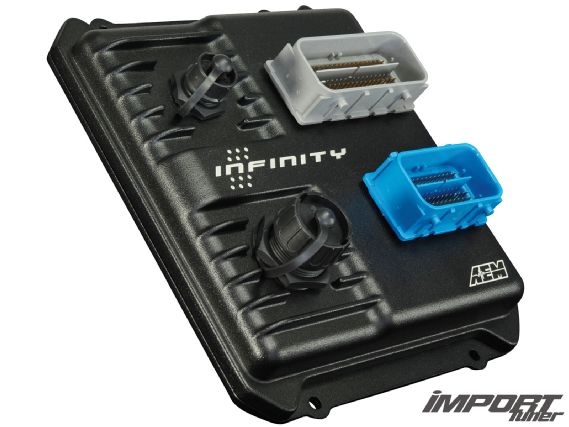 | AEM Infinity Engine Management System 02
| AEM Infinity Engine Management System 02
Historically, stand-alones are seen as expensive and hard to understand and tune. Most of all, stand-alones have the reputation of being a nightmare to wire, often requiring custom harnesses and additional sensors. The EMS has remained popular over the years thanks in part to the unit's plug-and-play capability, designed to use the factory sensors including selectable direct drive or 0-5V coil output for custom applications. From VTEC to rev limit, timing, ignition control, injector size compensation, boost control, built-in/real-time data logging capability, nitrous injection, even anti-lag and individual cylinder fuel and timing, the EMS seemingly has it all, or so we thought, until we caught glimpse of AEM's newest unit, dubbed the Infinity. Here's a number of reasons why you need to upgrade to the Infinity.
 | AEM Infinity Engine Management System
| AEM Infinity Engine Management System
Extreme Processing Power
AEM's new Infinity Programmable EMS represents a quantum leap in technological capability over virtually all existing powertrain controllers available today. Marketed by AEM as the most advanced programmable powertrain controller available, the Infinity eases the tuning process for even the most sophisticated engine combinations. The unit runs on a dual-core 200MHz 32-bit microprocessor, which is able to process 400 MIPS (400,000,000 instructions or "thoughts" per second) running a programmable-state machine on a real-time operating system. Compare the processing power to the previous Series 2 40MHz 16-bit microprocessor or one of the fastest OEM ECUs, which is reportedly capable of only 125 MIPS (average aftermarket EMS has less than 50 MIPS processing power), and you'll come to appreciate the technological advancements of the Infinity.
Nerding out yet? Pull out your stopwatches and simmer on this thought for a while. The Infinity EMS calculates injector pulse width in units of 1/10th of a microsecond. There are 1,000 microseconds in 1 millisecond. A millisecond is a lifetime to the hardware on this unit. This is fuel control resolution to 0.0000001 second. To say the Infinity delivers impressive fuel control would be an understatement.
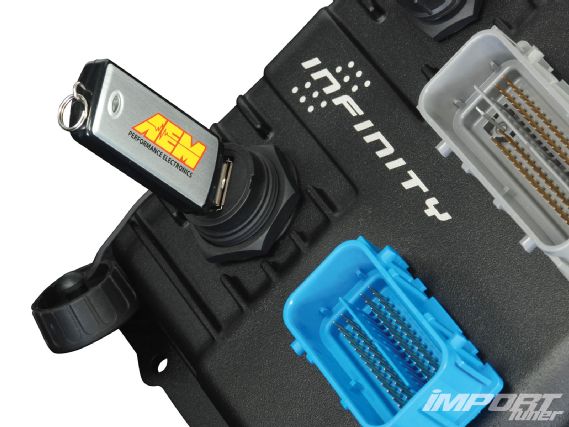 | AEM Infinity Engine Management System 06
| AEM Infinity Engine Management System 06
The Infinity features the latest in tuning technology, including auto learning modes for airflow, idle and boost control, a two-channel internal lambda interface wideband controller for consistent tuning, and real-time diagnostics protection, which constantly monitors and delivers sensor feedback (airflow, fuel pressure, oil pressure, engine temperatures, rpm, and knock), which alerts the ECM of any potential issue before it can cause engine damage.
It's no surprise that AEM engineers had new car technology and engine tuners in mind when developing the Infinity. The unit uses the latest in high-speed USB technology (up to 480 MB/second) and comes with 2 GB of internal logging memory, which can be increased to 32 GB using a FAT 32-formatted memory stick or expanded even further by plugging directly into your PC, automatic flex fuel adjustment for ethanol content that calibrates to fuel flow, ignition timing, and boost target (sensor is not included), as well as dual proprietary knock sensing for precise measurements of knock, to name a few.
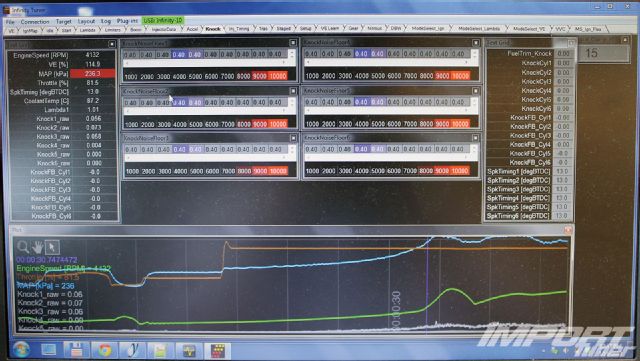 | AEM Infinity Engine Management System Data Table 04
| AEM Infinity Engine Management System Data Table 04
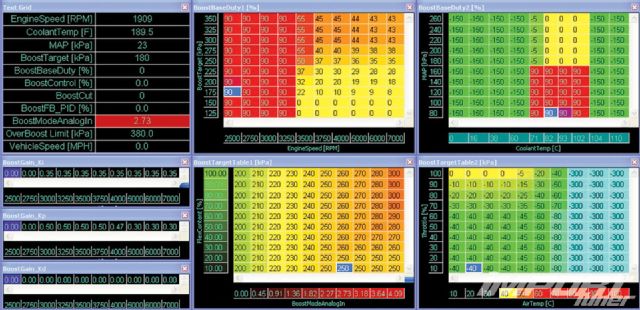 | AEM Infinity Engine Management System Data Table 05
| AEM Infinity Engine Management System Data Table 05
Simulation Mode
Tuning the Infinity has become more simplified and smarter than previous generations. A powerful input simulator feature is included, allowing the user to simulate input channels to the Infinity EMS. This allows you to make tuning changes and test the results by modifying input channels. It allows you to see whether, or how well, your tune will work before ever running the engine.
Integrated Technology
Infinity uses the latest printed circuit board (PCB) manufacturing processes for Ball Grid Array (BGA) and Quad Flat No-Lead (QFN) components. The PCB size is roughly 5.5 by 5.5 inches and includes 12 peak and hold injector drivers, 10 ignition outputs, and a host of other inputs/outputs (I/O). The circuit board to the left is the previous model AEM Series 2 unit, while the more compact unit on the right belongs to the new Infinity PCB.
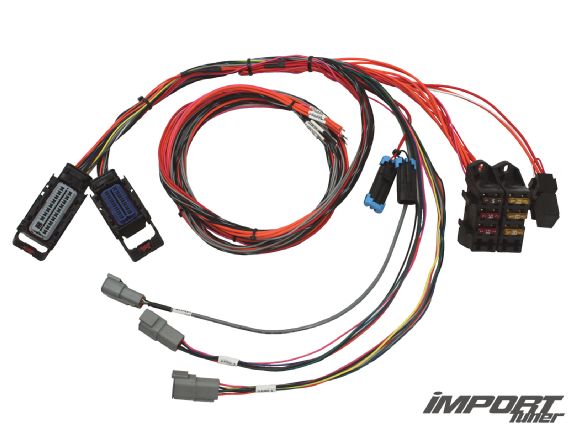 | AEM Infinity Engine Management System Circuit Boards 07
| AEM Infinity Engine Management System Circuit Boards 07
User Interface
The Infinity user interface is optimized for speed and performance with high-resolution 3-D graphics, and features user-selectable control types for custom layouts. An ECU Setup Wizard takes complex calibration setup work and simplifies it through a smart interface. The Infinity's data logging playback mode allows for calibration editing and all controls are synched to the logged data. This allows you to edit calibration data exactly where you need to and minimize your tuning time. A new, advanced data logging analysis package is also included.
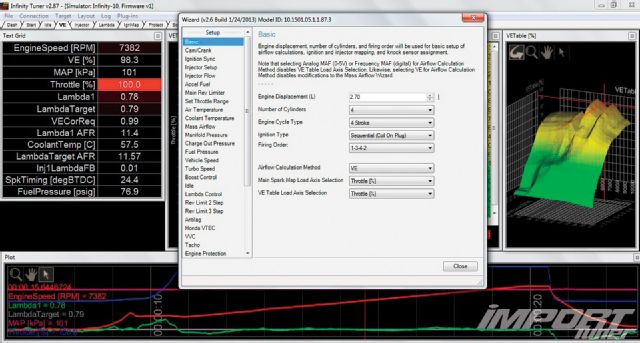 | AEM Infinity Engine Management System User Interface 08
| AEM Infinity Engine Management System User Interface 08
AEMdata Data Analysis Software
AEMdata provides an advanced interface for viewing the log files generated by the Infinity. It features superior graphics with a custom data analysis package that lets you review and playback logged data and overlay it using charts, dash displays, gauges, or custom display configurations. It will also track map and allow you to overlay logged data onto the track if you have installed a vehicle speed sensor (VSS) and accelerometer.
All logged channels are listed as individual channels in the software to ease setup. Users simply drag a channel log to a window to start logging. If your logging interface has an oil pressure gauge and you want to change it to log fuel pressure, drag the fuel pressure channel into the oil pressure gauge in your log interface, and the software makes the change.
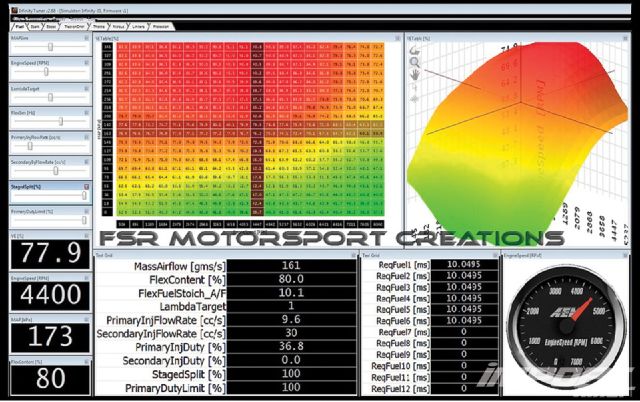 | AEM Infinity Engine Management System Aemdata Data Analysis Software 09
| AEM Infinity Engine Management System Aemdata Data Analysis Software 09
Advanced Tuning Package Upgrade
Advanced data logging and analysis software along with additional hardware outputs and sensor input is now available for purchase/download for the Infinity. The updated file offers the end user a multitude of features to further your vehicle performance and is currently available through AEM or your authorized AEM retailer.
Advanced Tuning Functions:
- No-lift shift
- 4-wheel speed traction control
- 3-step launch control
- Drive by wire
- 4-stage nitrous control (coming soon)
Advanced Tuning Hardware Outputs:
- 1 high side driver (coming soon)
- 2 H-bridge channels
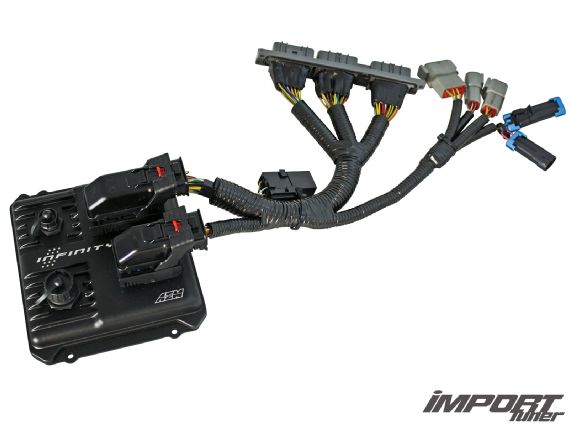 | AEM Infinity Engine Management System Advanced Tuning Package 10
| AEM Infinity Engine Management System Advanced Tuning Package 10
Advanced Tuning Inputs:
- 2 analog voltage inputs (4 additional coming soon)
- 2 VR/Mag differential pair inputs
- 1 digital/frequency input (coming soon)
- 3 analog temp inputs (coming soon)
- 4-stage nitrous control (coming soon)
 | AEM Infinity Engine Management System Aemdata Data Analysis Software 11
| AEM Infinity Engine Management System Aemdata Data Analysis Software 11
Infinity Series 2 EMS Series 1 EMS CPU Core 32-bit/200MHz 16-bit/40MHz 16-bit/16MHz Instructions per second 400 million 20 million 5 million On-Chip Flash 2MB 256KB N/A On-Chip RAM 128KB 12KB N/A (external) Analog to Digital 37 (12-bit) 22 (10-bit) 18 (10-bit) Injector Drivers Up to 12 Up to 12 Up to 10 Ignition Coil Drivers Up to 12 Up to 8 Up to 5 Data Logging Tested to 64 GB, external, playback mode with controls synchronization 1MB internal 512KB Traction Control 2- or 4-wheel slip, wheel speedor engine acceleration Engine acceleration based Engine acceleration based Knock Control 2-Channel adaptive User-adjustable sensor frequency No Launch Control Up to 3-step 2-step 2-step Communications USB 2.0 via IP67 rated (weatherproof) cables USB or serial RS232 (no USB) Internal Lambda Sensors 2 No, 2available inputs No, 2available inputs Construction Sealed, cast-aluminum enclosure(suitable for engine bay mounting) Extruded aluminum enclosure Extruded aluminum enclosure Multi-Fuel Capable Yes Yes No Flex Fuel Compensated Yes No No Internal Engine Simulator Yes No No Real-Time Diagnostics Yes No No Drive By Wire Yes PNP apps only PNP apps only
Smarter Tuning: Water/Methanol Systems
FSR Motorsports located in Montclair, CA, recently upgraded their customer's '95 Supra TT from AEM's standard 1-gallon tank to their huge 5-gallon reservoir setup. The system was installed and tuned on the Infinity ECU by FSR Motorsports co-owner and tuning expert Ian Sai-Ngarm. Prior to the AEM water/methanol system the Supra ran 485 whp at 14.5 psi on 91-octane. "Thankfully, this car is running AEM's fantastically flexible Infinity ECU. We already had a 12-position switch installed in the car, so we started to configure the tune to reflect the meth injection," he says. By using AEM's "mode switch", FSR is able to have different positions on the switch activate different boost, timing, and fuel maps as well as trigger an output. The Infinity includes up to four separate ignition maps, four separate lambda target maps and two separate VE maps with independent values. "Since we tune so many cars, we have a pretty good idea of what kind of adjustments needed to be made," he says. "We dropped in our revised fuel map, timing map, and boost maps, which are activated by the in-dash switch. After a couple runs to fine-tune the fuel delivery and boost, the Supra spun the rollers to the tune of 620 whp with the meth system active and extra boost."
 | AEM Infinity Engine Management System
| AEM Infinity Engine Management System
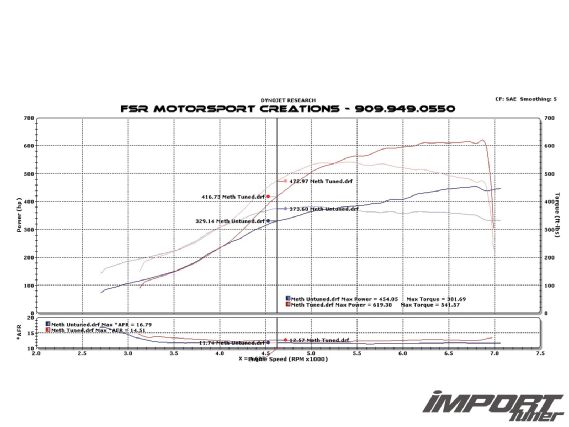 | FSR Motorsports 95 Toyota Supra TT Dynograph 13
| FSR Motorsports 95 Toyota Supra TT Dynograph 13
Fail-safe's are an important feature of the AEM meth injection system when paired with the Infinity EMS. The AEM meth injection system can detect a number of faults including a wiring problem, power problem, ground problem, or a low fluid level. When a problem is detected, the meth controller sends a signal to the Infinity. FSR setup the Infinity setup to revert to the low boost map and flash a light in case of any fail-safe by the meth controller. That means if you run out of meth during a pull, it will automatically flash a light at you, revert to a pump gas-only safe boost level, and automatically switch to pump gas safe timing and fuel delivery maps. When the fail-safe is cleared, it will automatically give you that extra horsepower and boost! Further, the AEM Infinity has built-in lean protection, which is a reactive system that will add injector duty to maintain a safe air/fuel if there is any meth delivery issue. If the correct air/fuel can't be maintained, it will automatically initiate a rev limiter (programmable) and flash a light, all in the name of engine safety.
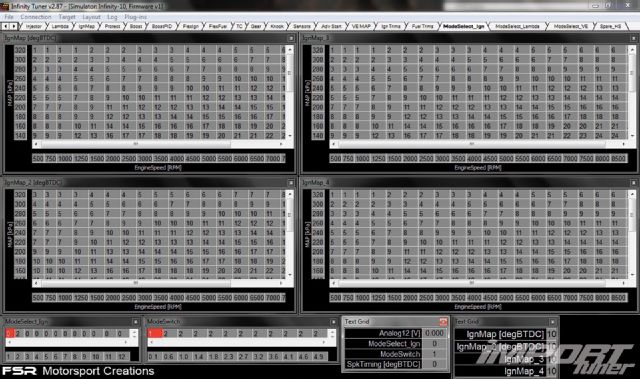 | FSR Motorsports 95 Toyota Supra TT Data Table 14
| FSR Motorsports 95 Toyota Supra TT Data Table 14
"Running 25 psi, along with altered timing and fuel maps, you can see by the graph and log that our air/fuel after the meth matches the air/fuel before the meth. That, along with the extra boost and timing, allows us to get a big bump in power safely! Because the Infinity gives us a time, super fast log of six different knock channels (one for each cylinder), we can see that the engine is completely happy with this extra power. If we were trying to push it, we'd keep turning it up and watching how much power we gain per psi, along with how much timing we have to pull out to find the maximum safe power we can run on pump and meth. Generally, however, we try to stay well below that threshold," Sai-Ngarm says.
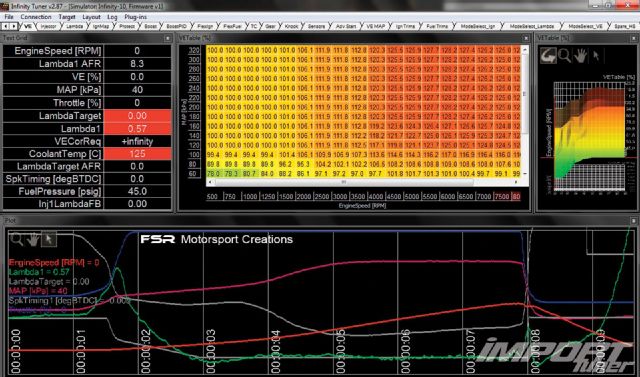 | FSR Motorsports 95 Toyota Supra TT Data Table 15
| FSR Motorsports 95 Toyota Supra TT Data Table 15
Racer Testimonials: Tried, True, and Tested
Professional teams across the world, ranging from drift and drag, to rally cross, have all recently made the switch to the new Infinity engine management system, including an elite number of sponsored vehicles.
Achilles Radial/Bridges Racing
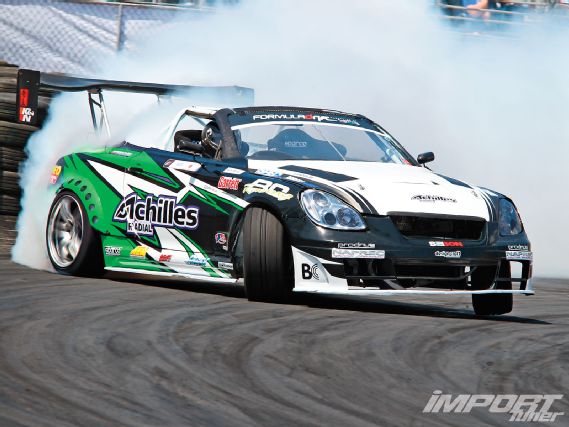 | Achilles Radial Bridges Racing Lexus SC430 16
| Achilles Radial Bridges Racing Lexus SC430 16
Vehicle: Lexus SC430
Driver: Daigo Saito
Engine: 2JZGTE
Horsepower: 1,200
Current Best Performance:
2012 Overall Formula Drift Leader
2012 Formula Drift Champion
2012 Formula Drift Asia Series Champion
Note: Current record at time of magazine print
Switched from AEM EMS Series 2 to Infinity
Many teams, including 2012 Formula D Champion Daigo Saito, know firsthand that you can't compromise when it comes to using good equipment. "When it came to selecting an engine management for Saito's Lexus SC430, we needed a reliable engine management system that was not only reliable but also allowed Saito to maintain that competitive edge. The Infinity engine management, for lack of words, is simply badass. It's got all bells and whistles comparable to all of the high-end engine management systems sold on the market today minus the price. This stand-alone fuel management system was designed to accomplish two things: dominate the engine management market and deliver the most bang-for-the-buck in terms of performance. We were able to tune the car with more midrange throttle response and power, which Daigo expressed was immediately noticeable on the drift course," says Gary Castillo, owner of Designcraft Fabrication and head chief mechanic for the three-car Achilles Tires drift team.
Papadakis/Scion/ Hankook Racing
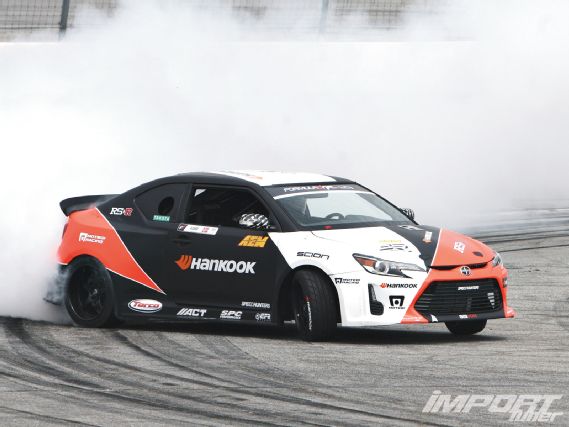 | Papadakis Scion Hankook Racing 14 Scion Tc 17
| Papadakis Scion Hankook Racing 14 Scion Tc 17
Vehicle: '14 Scion tC
Driver: Fredric Aasbo
Engine: Toyota 2AR-Turbo
Horsepower: 800 hp/700 lb-ft of torque
Current Best Performance:
2010 Formula Drift Rookie of the Year Award
2011 Formula Drift UAE Invitational Champion
2011 Formula Drift Texas Speedway Invitational Champion
2011 and 2012 British Drift Championship Silverstone Super Pro Champion
Note: Current record at time of magazine print
Switched from AEM EMS Series 2 to Infinity
 | AEM Infinity Engine Management System
| AEM Infinity Engine Management System
Fellow drifting competitor Fredric Assbo in the Papadakis Racing Scion tC comes into the 2013 Formula D Championship series equipped with the AEM Infinity unit. Import Tuner had an opportunity to spend a full day with the race team as they prepared for the inaugural FD season one event taking place in Long Beach, CA. Race manager Stephan Papadakis outlined a number of key tuning features the team took advantage of when switching from the AEM Series 2 to Infinity.
1. Drive by wire. "We are able to choose our pedal and throttle body we wished to use and create a custom throttle cam. The software has a table where you program what throttle pedal position equals any throttle-body opening you desire," Papadakis says.
2. Extra logging. "We can now log gigs of data on the external USB drive. Currently, we log 40-plus parameters of the engine systems so after each run/day we can download the data and check everything from variable cam timing to oil pressure in the attempt to catch problems early or just verify all is running properly," Papadakis says.
3. Tuning software: "One great thing about the new tuning software is after a dyno run, as you are looking at the data, the maps all show what cell the system is using. For example, you might place your cursor over a lean spot on the log graph, at the same time that cell on the fuel map will be highlighted for easy reference of where to change. This makes tuning quicker and more precise," Papadakis says.
 | AEM Infinity Engine Management System
| AEM Infinity Engine Management System
Speed Factory/Sipes Brothers
 | AEM Infinity Engine Management System
| AEM Infinity Engine Management System
Vehicle: '93 Honda Civic VX (all motor)
Driver: Joel Sipes
Engine: K24 (2.7L)
Horsepower: 415 hp/275 lb-ft of torque
Current Best Performance: 9.81 at 137 mph
Title: All Motor Street Record Holders
Note: Current record at time of magazine print
Switched from AEM EMS Series 2 to Infinity
The Sipes brothers are no strangers to the Honda drag racing world. Currently owning the All Motor Street Record, the Speed Factory/Sipes Civic began the 2013 season with the aid of the AEM Infinity. "We used to run Hondata's K-Pro system on this car, and it worked well, but we found ourselves wanting more advanced features. The Infinity system has been great, giving us better control and reliability that has resulted in more power, faster passes, and more consistent performance with increased safety. I really like the GUI and the ability to review datalogs within the calibration and have map tracing showing you exactly what areas of the calibration it was using; this greatly speeds up the tuning process and is a feature that is sorely lacking in many other stand-alone systems.
"The VE-based tuning strategy is also really neat; it's constantly making fueling calculations based on the VE table and sensor inputs rather than just running a value in a table and then making closed-loop AFR corrections afterward like many other systems.
"This allows us, for example, to test power differences from running different base fuel pressures by simply adjusting the FPR. No retuning is needed, as it monitors and uses the fuel pressure readings to calculate the needed injector pulse width to achieve the targeted lambda values.
"The map switching and engine protection strategies that are built-in are great features as well. On top of the Infinity's abilities, the tech support from AEM is also top notch. I really look forward to using more of its advanced features in the future," says James Kempf, tuner at Speed Factory.
Nitto Tires/Fatlace Racing
 | Nitto Tires Fatlace Racing 95 Nissan S14 21
| Nitto Tires Fatlace Racing 95 Nissan S14 21
Vehicle: '95 Nissan S14
Driver: Matt Powers
Engine: Katech Track Attack 463 LS1
Horsepower: 700 hp/700 lb-ft of torque
Current Best Performance:
2011 Ranked Sixth overall for Formula Drift Season
2011 Most improved/Hardest Charging/ Best Style Driver
2012 Ranked Tenth overall for Formula Drift Season
2012 Red Bull Drift Shifters NZ Champion
2013 Motegi Super Drift Champion
Note: Current record at time of magazine print
Switched from AEM EMS Series 2 to Infinity
Matt Powers enters the 2013 Formula Drift Championship season with a great deal of confidence. "Switching to the Infinity system really allows the team to make quick and easy adjustments to the tuning maps at the track when needed. The ability to check data logging throughout the entire day's competition event ensures the Nissan S14 is fully dialed in. The Infinity's reliability really helps my confidence and performance with each competitive weekend. We definitely have no regrets switching over to the new Infinity system knowing what we know now. The new setup offers tons of performance features and reliability advantages that allow me to concentrate on competing," Powers says.
Real Street Performance
 | AEM Infinity Engine Management System
| AEM Infinity Engine Management System
Vehicle: '04 Honda S2000 Turbo
Driver: Carey Bales
Engine: F22C
Horsepower: 1,100-plus whp
Current Best Performance: 7.92 at 176 mph
Title: Class Record Holder in NHRA SS
Switched from AEM EMS Series 2 to Infinity
Note: Current record at time of magazine print
Switched from AEM EMS Series 2 to Infinity
Carey Bales, owner and driver of the quickest and fastest car in NHRA Super Stock, switched from AEM's Series 2 EMS to the Infinity ECU. Bales is one of many racers/teams switching from the AEM Series 2 to the Infinity. "Our transition from the AEM Series 2 to the Infinity was seamless. I built and designed the new engine wiring harness with the guidance of our engine tuner Devin Pearce. In addition to the new Infinity system we added a bigger set of secondary injectors over last year, a newly redesigned turbo manifold from Full-Race motorsports, and a fresh engine from InlinePro. When Pearce showed up to the dyno, we had the S2000 idling like stock within half an hour. We actually started the engine up on the same startup and idle tables that had previously started and idled a Viper, Supra, and Challenger. I found this to be incredible.
"Within eight passes, and only two full passes, we were running numbers like the end of last season, at considerably less boost. Numbers that took us an entire season to achieve last season were done in just eight passes with the new Infinity system. We went 8.0 at 173 mph on our second full pass with the Infinity system," Bales says.
During competition, an engine problem caused the fuel pressure to suddenly drop midway through a quarter-mile pass under high boost. Bales claims the Infinity ECU immediately caught the fuel pressure drop by adjusting the fuel tables. The Infinity's ability to dial back engine parameters along with open-loop fuel pressure compensation saved the motor from catastrophic disaster. "We didn't even see a blip in the A/F ratio numbers. Since using the Infinity, we've started this car in temps anywhere between 30 and 90 degrees F, and it starts up and idles like it's stock, except for the nice sounding cams, of course," Bales says.
Global Rallycross
 | Global Rallycross GRS Ford Focus 23
| Global Rallycross GRS Ford Focus 23
The Global Rallycross Championship entered its third season with events taking place across the globe. GRC gained notoriety as well as popularity over the years, thanks to X Games 16 in Los Angeles in 2010, where cars smashed and tumbled to the checkered flag as Rockstar Energy Drink driver Tanner Foust took the win. This year, GRS took the next step in securing their presence in the sport by birthing a Superlite series. Based on the Ford Focus chassis, these Olsbergs MSE Superlite vehicles sport half the power of their older brothers at the tune of 400 whp, but more importantly, all 22 vehicles will be running on the Infinity EMS as their official spec engine management system. "We chose to use the Infinity ECU on the Olsbergs MSE Global Rallycross Superlites cars because of the system's advanced processing capability, and the technical support provided by AEM electronics engineers. The processor speed is very fast and is poised to grow in features, which eliminates any limitations as the Superlites program evolves. AEM's network of factory-trained tuners ensures we always have support when and where we need it as well," says Brad Manka, Olsbergs MSE.
Bisimoto Engineering
 | AEM Infinity Engine Management System
| AEM Infinity Engine Management System
Vehicles: '12 Honda Civic Si/'06 Honda Insight
Driver: Bisi Eserioha
Engine: K24Z7/F22A
Horsepower: 1,004 whp/494 whp
Current Best Performance: TBD/9.26 at 152 mph
Title: World's Quickest/Fastest Unibody Naturally Aspirated FWD
Note: Current record at time of magazine print
 | AEM Infinity Engine Management System
| AEM Infinity Engine Management System
"In the motorsport community, we have been accustomed to 8-bit processors, with millions of instructions per second (MIP) counts on the 30-40 range, limited logging capability. With AEM the new Infinity, access to 400 MIP, 3-bit, single-board, rugged, programmable ECU is now possible. Why is such processing power appealing? In a world of rev-happy, high-horsepower turbocharged and high-compression powerplants, with rpm exceeding the 10,000-rpm mark, resolution and pickup accuracy is paramount. Inaccurate engine position parameters could easily spell disaster, in the name of an expired engine. With older ECMs that may process information every other revolution or even between two trigger teeth, lower rpm accuracy is marginally fine. Until the engine eclipses the 10,000-plus rpm region, then those processors have a hard time keeping up, resulting in misfires, inaccurate timing events, and dangerous cranking events especially in high-compression engines, etc. These issues are solved with the Infinity offering fast, full modeling, opposed to interpreting old data, as the quick processor can keep up with the ultrafast acceleration and deceleration of the engine, while still maintaining the highest resolution up to 100,000 rpm! To engineers and tuners, having absolutely no practical crank tooth resolution limit, superb traction control protocols, high and robust data logging, coupled with the latest ability to calculate injector pulse width in units of 1/10th of a microsecond is heavenly!" Eserioha says.
 | AEM Infinity Engine Management System
| AEM Infinity Engine Management System
AEM Infinity Features:
 | AEM Infinity Engine Management System 27
| AEM Infinity Engine Management System 27
- 6x6x2 inches (1.125-inch height without connectors)
- 24 ounces/680.4 grams
- 32-bit, 200MHz 400 MIPS primary microprocessor
- 20MHz auxiliary microprocessor
- Cast, sealed aluminum enclosure
- 129-pin motorsports-quality harness with fully sealed automotive connectors
- Compatible with most factory and performance aftermarket sensors
- Includes start-up configurations
- Runs on Windows-compatible software
- Tune using weatherproof USB communication port
- Encrypted maps prevent unauthorized usage or sharing
- Up to 12 peak and hold injector drivers
- Up to 12 (0-5V) ignition outputs
- 14 general-purpose outputs
- 3 analog temp inputs (additional 3 with Advanced Tuning Package)
- 11 analog voltage inputs (additional 6 with Advanced Tuning Package)
- 7 digital inputs (additional 1 with Advanced Tuning Package)
- 4 VR/Mag differential pair inputs (additional 2 with Advanced Tuning Package)
- Variable cam control (up to four cams, application dependent)
- High-speed USB data logging to mass storage device (4 GB included, tested to 64 GB)
- Internal data logging playback mode on every channel, synchronized with all controls
- Programmable traction control, two-wheel speed or engine acceleration (four-wheel speed with Advanced Tuning Package)
- Flex fuel compensated-fuel, ignition, and boost with blend
- Full idle control
- 2-Channel H-Bridge for drive by wire or other DC motor control
- 2-Channel adaptive knock control
- Multiple boost control strategies (time, gear, vehicle speed, switch, and more)
- Drive by wire (with Advanced Tuning Package)
- Programmable launch control
- User configurable soft-cut rev limiters, two-step rev limiters and anti-lag
- Map switching (four separate ignition maps, four separate lambda target maps, two separate VE tables)
- Wet or dry nitrous control (up to four stages)
- Integrated engine protection strategies
- Target lambda table, 10x10
- Open-loop fuel pressure compensation
- O2 lean-out protection
- Works with all AEMnet-equipped devices
- 2-Channel CAN included
- Internal Engine Simulator
Note: Dependent on flash drive size.
Photos courtesy of Vehicle Owners

